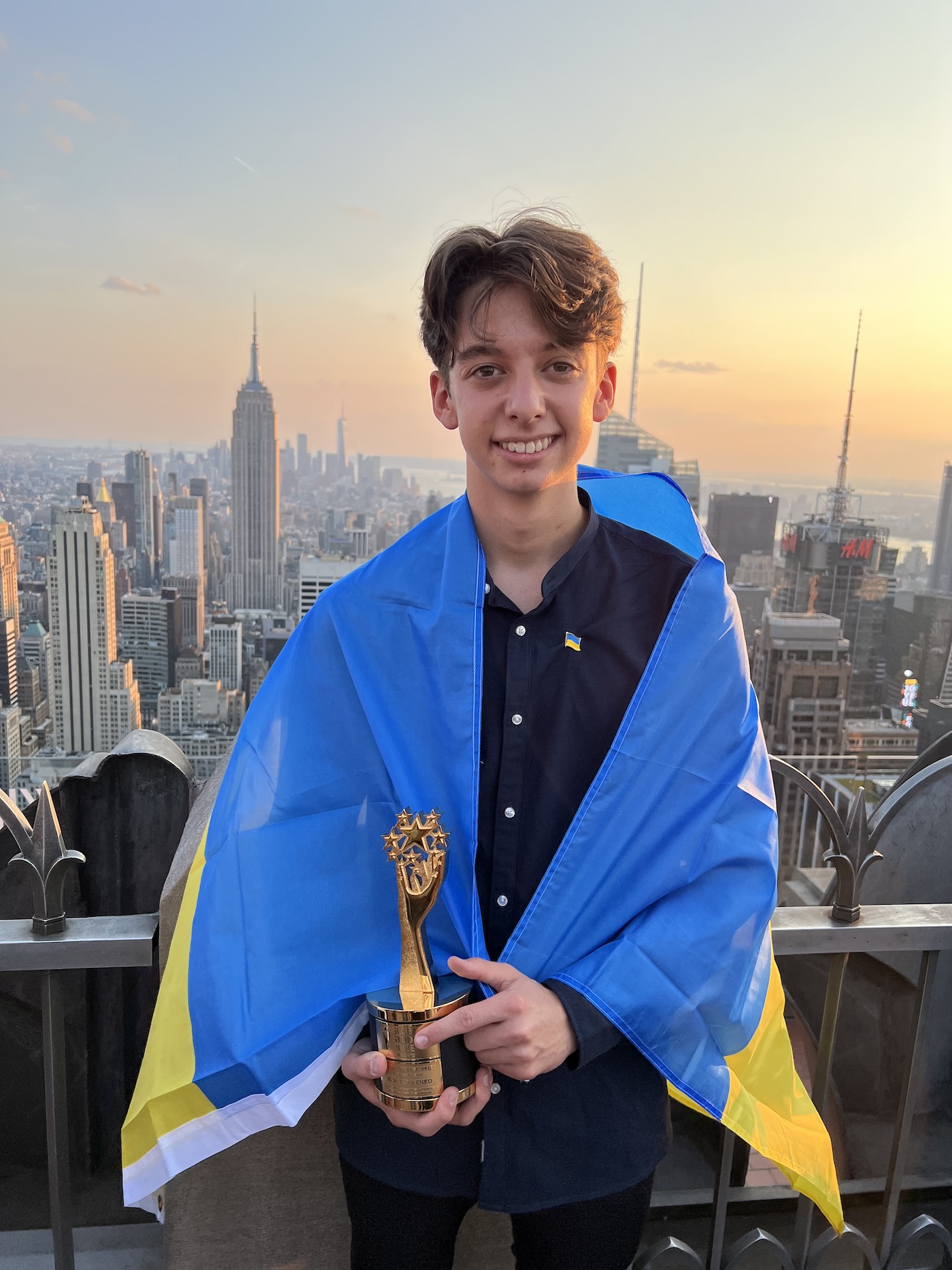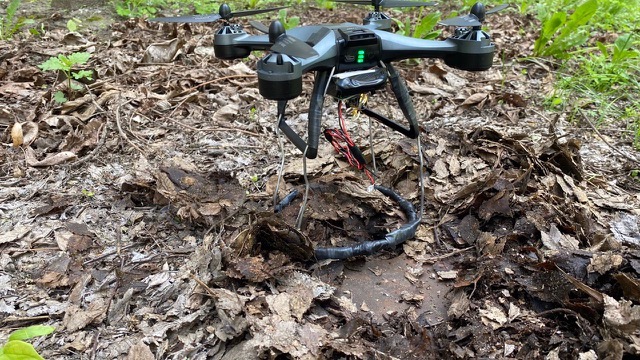Ukraine’s Ongoing Tragedy Inspires Teenage Inventor To Locate Landmines
7:44 minutes

 Igor Klymenko is a 17-year-old inventor from Ukraine, and he recently won the Chegg.org Global Student Prize—a $100,000 award given to a young change-maker. Klymenko won it for his invention, the Quadcopter Mines Detector, which is designed to locate underground landmines. The issue of unexploded landmines cannot be understated—some estimates show there could be about 100 million of them scattered across the globe.
Igor Klymenko is a 17-year-old inventor from Ukraine, and he recently won the Chegg.org Global Student Prize—a $100,000 award given to a young change-maker. Klymenko won it for his invention, the Quadcopter Mines Detector, which is designed to locate underground landmines. The issue of unexploded landmines cannot be understated—some estimates show there could be about 100 million of them scattered across the globe.
Klymenko is a student at both the University of Alberta in Canada and the Igor Sikorsky Kyiv Polytechnic Institute in Ukraine. He joins Ira this week to talk about the Quadcopter Mines Detector, and how he’s trying to help his home country, Ukraine, through engineering.

Invest in quality science journalism by making a donation to Science Friday.
Igor Klymenko is an inventor and student at the University of Alberta in Canada and the Igor Sikorsky Kyiv Polytechnic Institute in Ukraine.
IRA FLATOW: This is Science Friday. I’m Ira Flatow. If you listen to this show, you know we love highlighting young inventors. And this week, the winner of the Chegg.org Global Student Prize was announced. It’s $100,000 awarded to a young changemaker, and it went to 17-year-old Igor Klymenko from Kiev, Ukraine. His invention, the quadcopter mines detector, is designed to identify the location of landmines.
The issue of unexploded landmines cannot be understated. Some estimates show there could be about 100 million of them scattered around the world. And Igor brings a certain personal urgency to his invention, because of the war in his home country, Ukraine.
Igor is a student at both the University of Alberta in Canada and the Igor Sikorsky Kyiv Polytech Institute in Ukraine, and he joins me now from New York. Igor, Welcome to Science Friday.
IGOR KLYMENKO: Hello. So thank you very much for this opportunity. It’s a pleasure for me to speak to you today.
IRA FLATOW: Well, congratulations. How does it feel to win this competition?
IGOR KLYMENKO: Oh, I’m so excited because a lot of opportunities open up for me now. Now I can speak with other top finalists and we can make a community, so we can find solutions not for only educational problems that are common in the world, but also for other problems.
Also, I’m so excited because yesterday I had been– had speech on the Clinton Global Initiative. And I spoke with a lot of leaders of education across the world. So I’m so excited to have this opportunity to change the world for better.
IRA FLATOW: Igor, what inspired you to invent the quadcopter mines detector?
IGOR KLYMENKO: The idea came to me in 2014, when Russia attacked Crimea. I was 9, and I saw that how can I, usual student, help my people who are defending my country, help me people who are fighting on the borders of my country? And I decided that I realized that I can come up with some innovation. I can create some machine that can save lives, that can help people.
And I started researching problems, common awful problems that were connected to Ukraine at that time. And one of them was the landmining problem. I heard about consequences of that problem, and they were really awful. And after that, I started thinking about solutions. I started thinking about robotics for demining territories. And in 2020, I was interested in drones, and I started working on this project on a drone for detecting landmines remotely.
IRA FLATOW: So how does the drone find the landmines?
IGOR KLYMENKO: It’s drones implemented with the metal detectors. They are moving along a trajectory and transmitting a signal remotely to the user. After that, the signal is calculated by the algorithms that I have created by myself, and it’s providing exact coordinates of the land mines.
Also, I have created a program that is not only calculating the coordinates, but also creates a mock up map which can be put on the satellite photo and providded to sappers, to the military. And now we are working on a bigger prototype. It will be a drone which will not only give coordinates and mock up map, but also provide the exact type of the landmine and the way of safety removal. Also, this drone will spray paint on the exact location of the landmine. So we are going to use artificial intelligence to add this function to the new drone, to make this process much safer and much faster.
IRA FLATOW: Wow. So this drone can detect mines underground and create a map of where they are, and now you’re working on getting this drone to sense what kind of landmine is there, which will let people know how to deactivate it. That is amazing, and I know it could save a lot of lives. And I imagine the current war in Ukraine has influenced your work on the drone and made it even more urgent for you, right?
IGOR KLYMENKO: Yes, yes. After February 24, I and my family moved to the countryside. We were living in a basement for several months. And after three or four weeks, when I heard missiles, sounds of missiles, sounds of planes and we were just really scared in the basement, I realized that I shouldn’t stop. I should just continue working on my project because I was the most determined than ever before to create this device, to create this prototype because I heard a lot about people who are defending my country.
And after that, we also started volunteering with my parents, with my family. We started preparing and delivering food. So we just started working more and more to develop this project faster.
IRA FLATOW: And you were working on this during the war right in a basement, you say, with other people living there?
IGOR KLYMENKO: Yes. I was sheltering with eight people for several months, that’s after the beginning of active part of the war in Ukraine. It was really hard because that day, we took our grandparents and moved to our countryside, to the city of Vasylkiv. And there was living I and eight people. It was really hard, but I was with my family, so we were close to each other.
But unfortunately, there were a lot of friends, my friends who are in different cities, of Kyiv, in Kherson, in Kyiv, just in different parts of Ukraine. And I was nervous about them. And I had been teaching students, and one of my students was from Kherson. And the city was occupied by Russians, so it was really hard for us to read news to get new information from my friends who were in cities attacked by the Russians. So it was really hard.
IRA FLATOW: So now that you’ve won the $100,000 prize, what’s next for the quadcopter and your other possible inventions?
IGOR KLYMENKO: So now I’m going to invest most part of the money to developing this project with this prototype because I think that my mission in life is to create this prototype for detecting landmines, and another prototype for removing landmines. So my big plan is to finish with a drone for detecting landmines, provide it, certificate it in Ukraine. After that, I spoke with a Ukrainian factory, which is creating the military equipment. And they told me that if I will have minimum viable product, I will repeat, they can just make it mass production and help me to provide most of the military in Ukraine with this device.
And after that, I want to start another project, a drone for removing landmines, to avoid using human factor while demining process at all, to save more lives as we can because I think the human life is the most valuable thing that we have.
IRA FLATOW: Before we go, tell me what it means to you to help Ukraine through this invention.
IGOR KLYMENKO: Oh, it’s a pleasure for me. It makes me happy and inspired because I can save human lives. I can help my people, who are defending my country. This time, this is a really hard time for Ukraine, but with support of Ukrainians, with support of the other countries, we can defend our country. And it just makes me happy that I can help my people. I can provide this device to them, and I can save a life of somebody’s father, somebody’s brother, or just somebody’s son. And that makes me happy. And that makes me just inspiring.
IRA FLATOW: Well, Igor, well wishes to you and your family in Ukraine, and thank you for taking time to join with us. And congratulations again to you.
IGOR KLYMENKO: Thank you very much Thank you very much.
IRA FLATOW: Igor Klymenko, a 17-year-old inventor from Ukraine and student at the University of Alberta in Canada and the Igor Sikorsky Kyiv Polytech Institute in Ukraine.
Rasha Aridi is a producer for Science Friday and the inaugural Outrider/Burroughs Wellcome Fund Fellow. She loves stories about weird critters, science adventures, and the intersection of science and history.
Ira Flatow is the founder and host of Science Friday. His green thumb has revived many an office plant at death’s door.